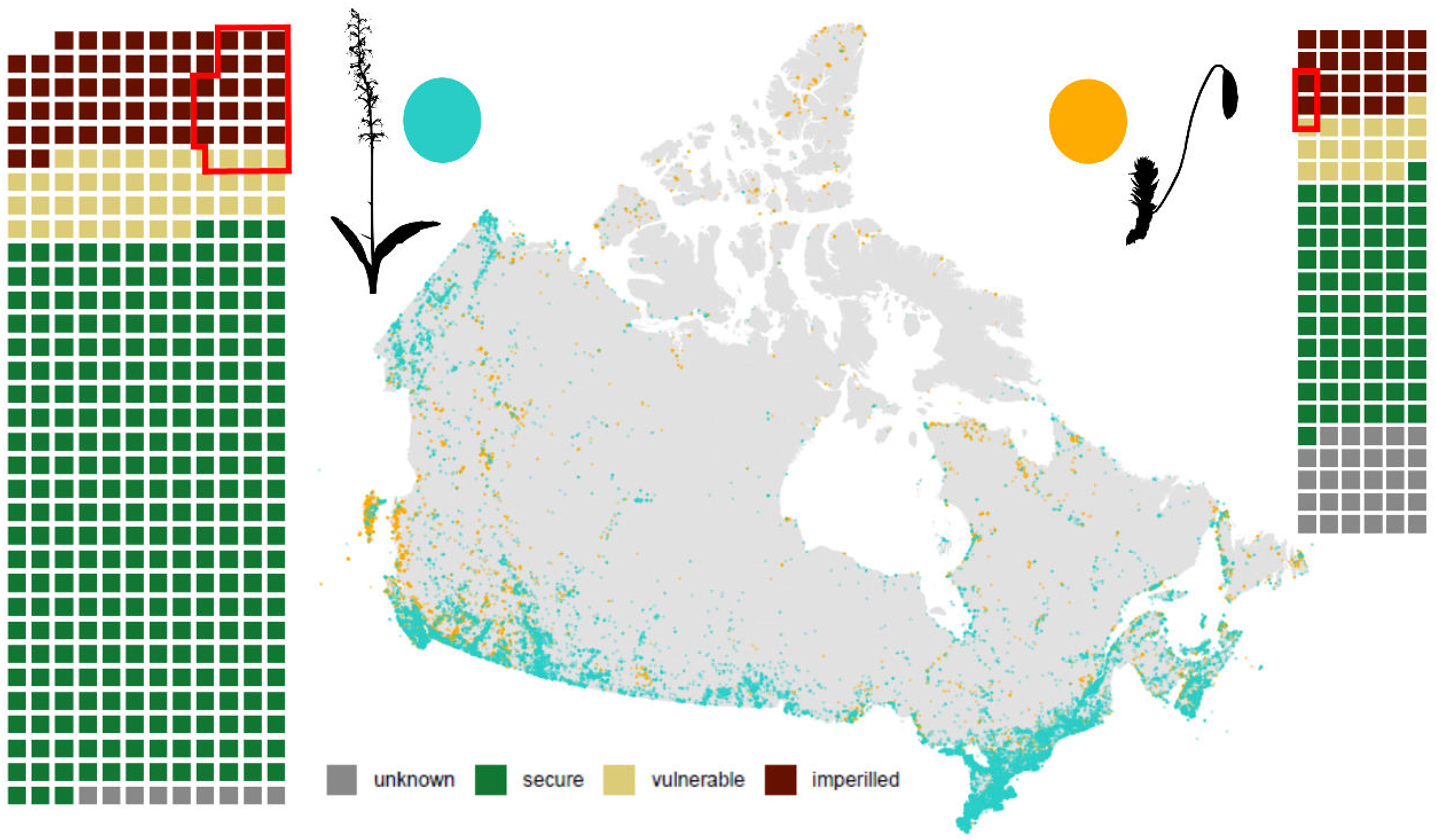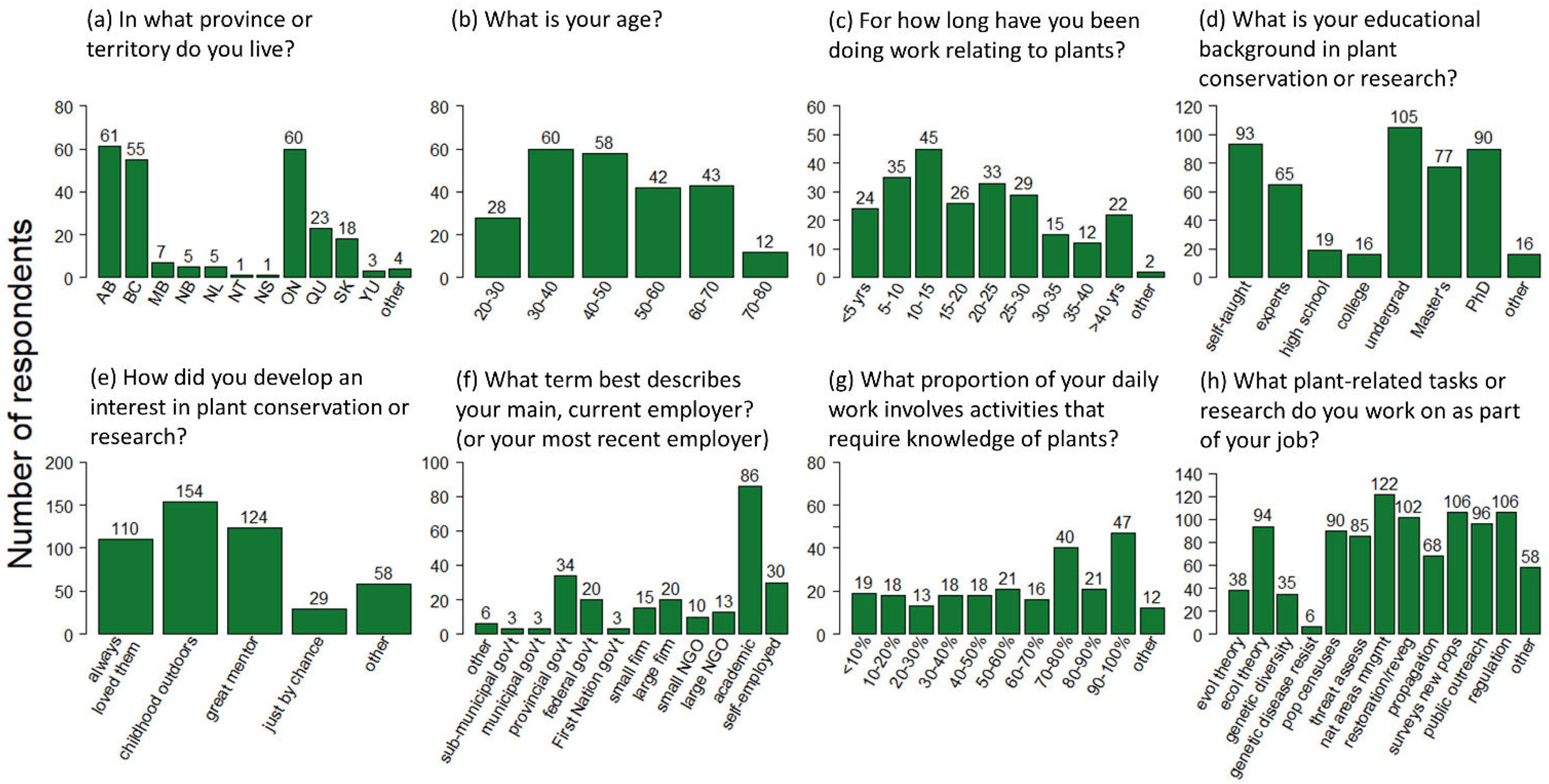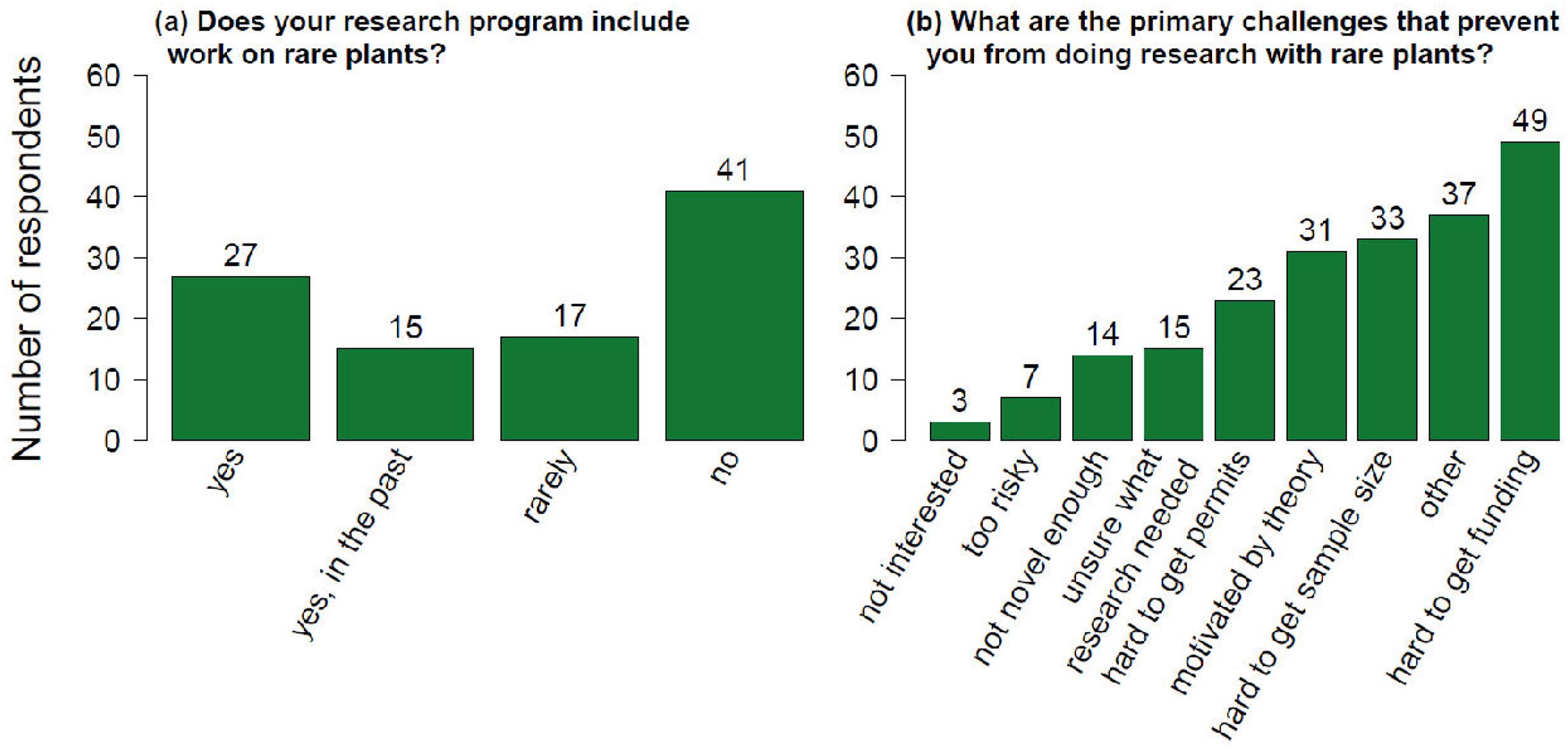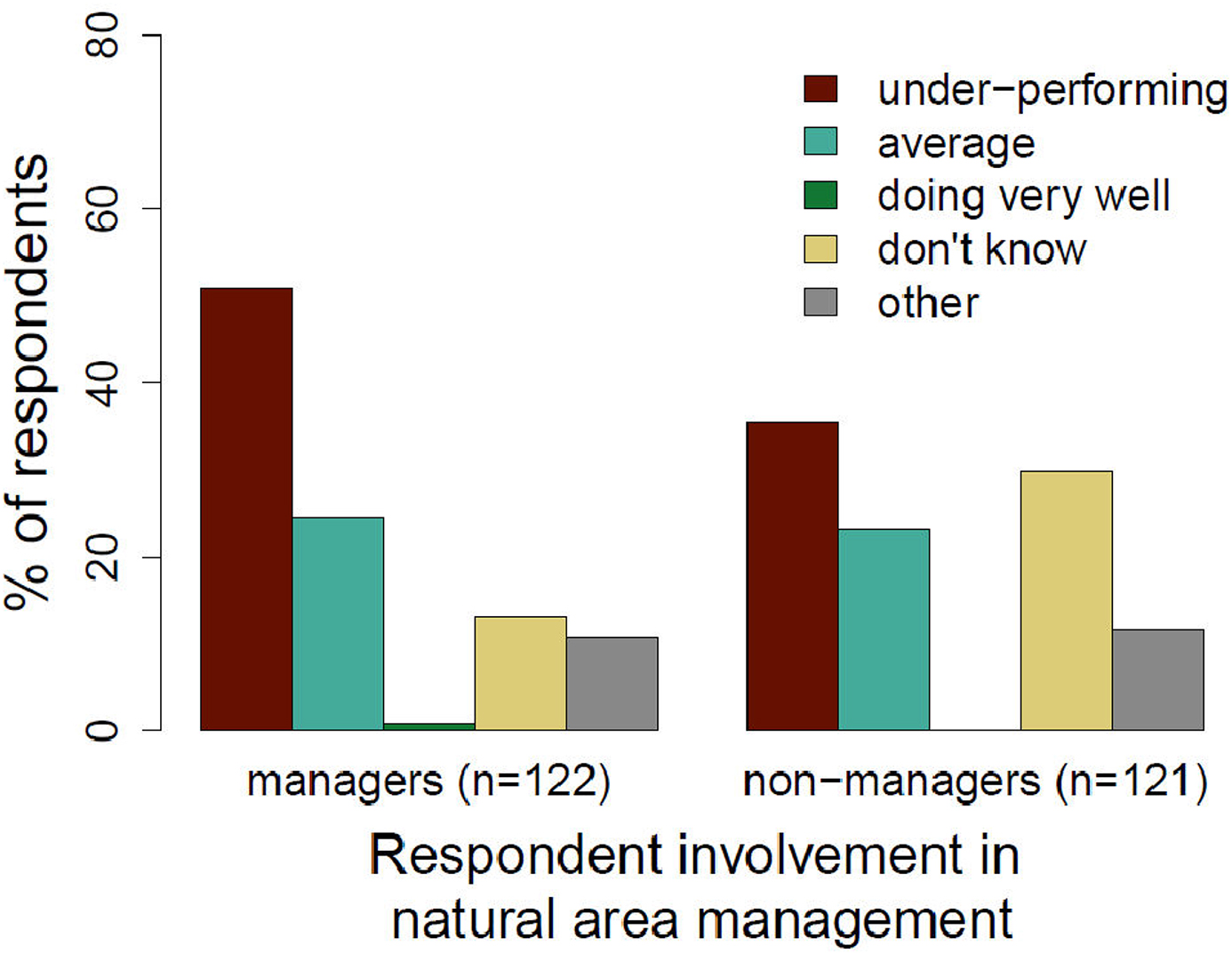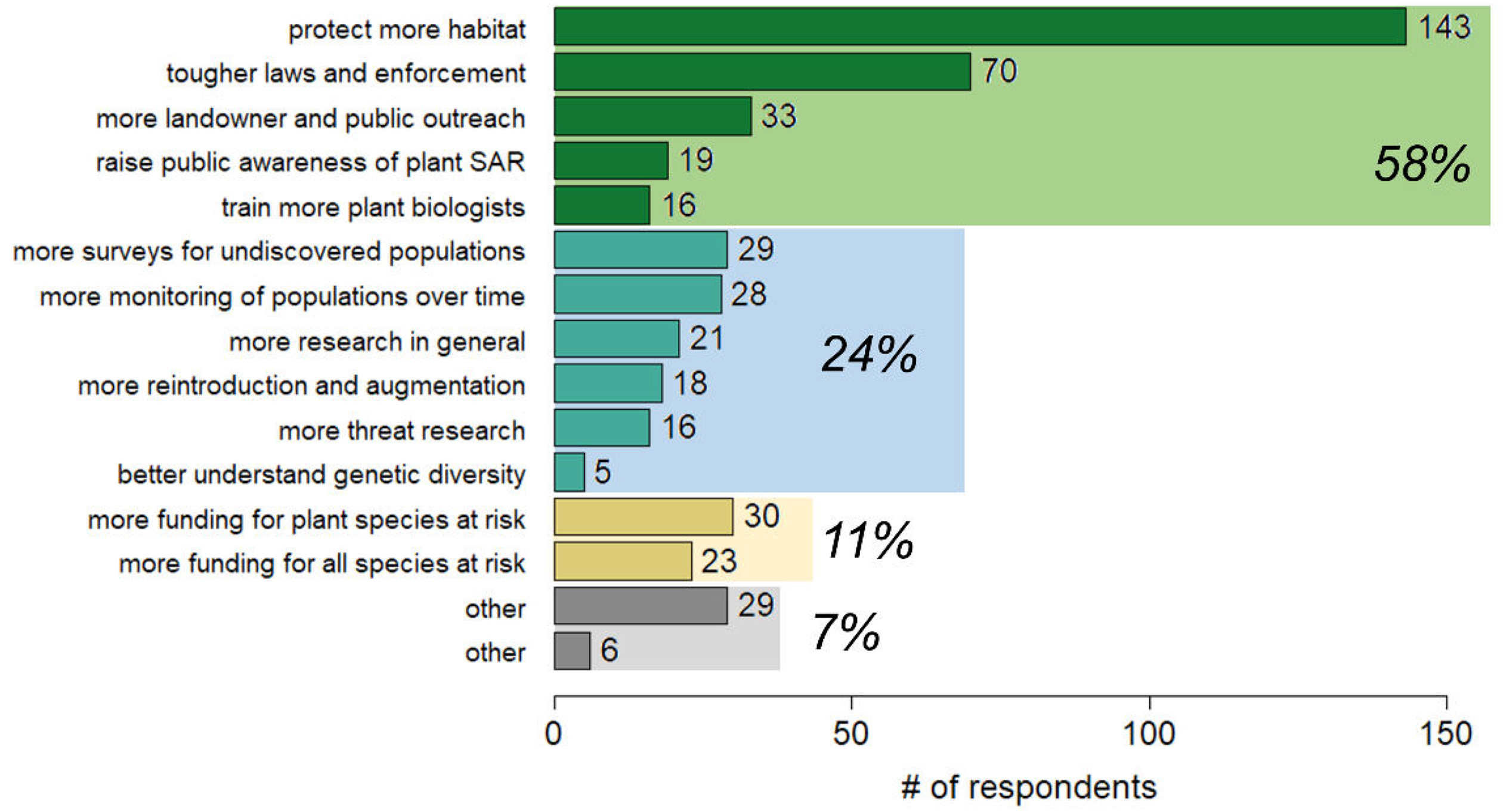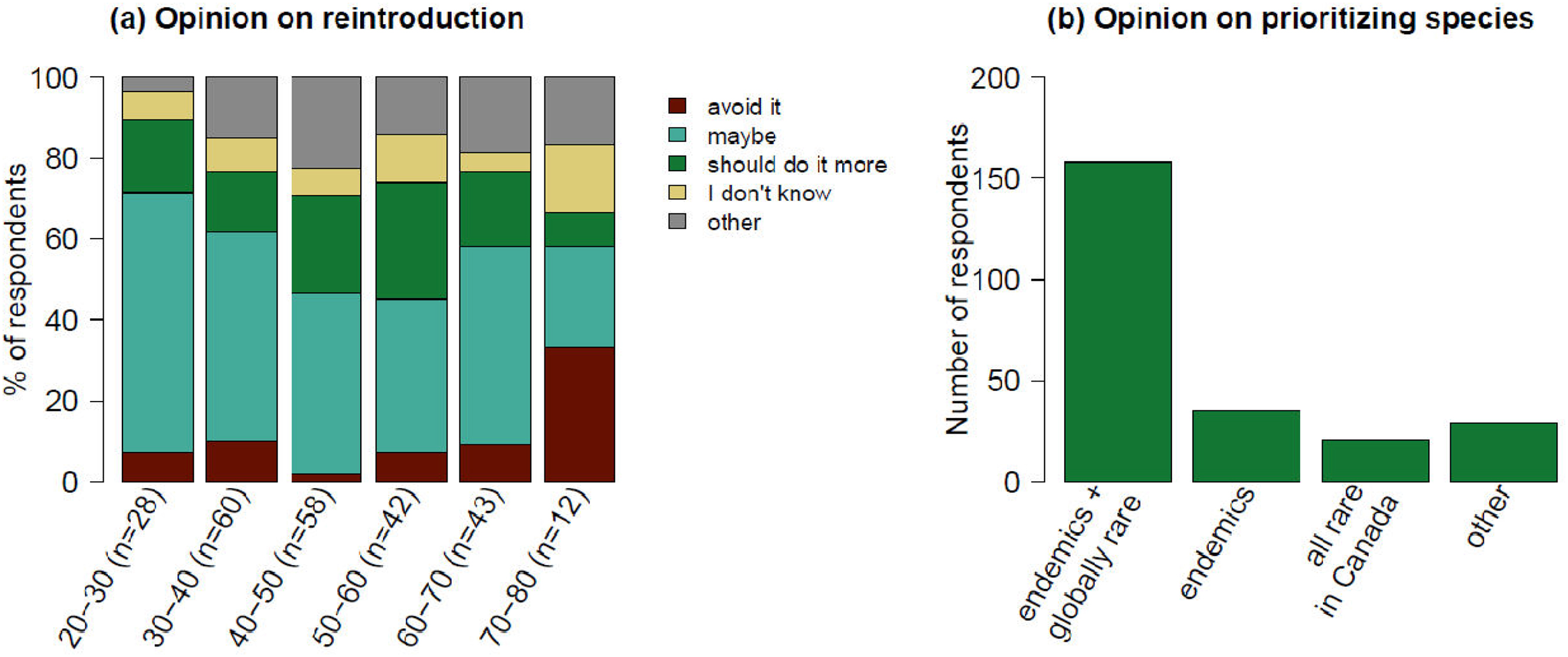Introduction
Plants are a major component of Canada’s biodiversity. The most recent Wild Species Report estimates that 3952 vascular plants and 1389 bryophytes are native to Canada (
Canadian Endangered Species Conservation Council 2022;
Fig. 1). Plants generate oxygen, store carbon, reduce flooding and erosion, structure and enrich the soil, and provide habitat and food for animals. We depend on them for building materials and medicines. Plant species also have inherent value, regardless of their utility to humans or other animals—a perspective that is explicitly recognized in the preamble of Canada’s Species at Risk Act (
SARA 2002).
About one quarter of Canada’s native vascular plants and bryophytes face some level of potential risk (
Fig. 1). Plants are the taxonomic group with the greatest number of species listed under the SARA: they make up 32.8% of the 671 species listed on Schedule 1 of the act, with 199 vascular plants and 21 bryophytes (all mosses) listed. Unfortunately, the listing of plant species has not resulted in much progress toward their recovery. Very few of the vascular plants assessed more than once by the Committee on the Status of Endangered Wildlife in Canada (COSEWIC) have improved in status over time—and many of those status changes were due to the discovery of previously undocumented populations (
Favaro et al. 2014; Kraus et al. in prep). For example, giant helleborine (
Epipactis gigantea), Pitcher’s thistle (
Cirsium pitcheri), and dwarf lake iris (
Iris lacustris) were each designated a lower risk status after the original COSEWIC assessment led to bolstered field survey efforts, which subsequently revealed additional populations (
COSEWIC 2010a,
2010b,
2015). Indeed, only four of the vascular plants that have been assessed more than once show evidence of genuine recovery as the result of conservation actions (Kraus et al. in prep).
Canada faces many challenges when it comes to plant conservation. While the flora is relatively small (e.g., Australia has more than 21 000 plant species,
Broadhurst and Coates 2017), it is spread over a vast area. Even in highly populated areas of Canada there are plenty of places that are not well surveyed by botanists—hence, the relatively frequent discovery of previously undocumented populations of plant species at risk (e.g.,
Tindall et al. 2004;
COSEWIC 2019,
2022;
McCune 2019). Plant diversity is concentrated in the warmer southern regions, which is also where most of the human population lives (
Coristine and Kerr 2011), and where most of the land is privately owned (
Fig. 1). About one third of all plant species at risk have the majority of their known populations on private land (
McCune and Morrison 2020). However, many landowners are unaware of plant species at risk that may grow on their property (
Olive and McCune 2017)—likely part of a broader trend of public lack of awareness of plants globally (e.g.,
Balding and Williams 2016). In addition, the SARA does not automatically prohibit the killing or harming of plant species at risk on private land—or protect critical habitat there. While seven provinces or territories have their own endangered species laws, only Ontario has provisions to protect listed species on private land (
Olive 2014;
WCS Canada 2022), although the Ontario Endangered Species Act is rarely enforced on private land (
Office of the Auditor General of Ontario 2021). Other provinces lack such laws or protect very few or no plant species under them. Federal programs have invested less money on the stewardship of plants relative to vertebrates (
McCune and Morrison 2020), even though conservation of at-risk plants is the most cost-effective way to maximize the number of species recovered because the cost of conserving plant species is often far lower than the cost of conserving species of mammals or birds (
Gordon et al. 2020).
There are large gaps in knowledge about the life history, threats, population trends, and habitat requirements needed to recover plant species at risk in Canada. Despite a strong tradition of academic research in plant ecology, evolution, and systematics in Canada, fewer than half of the plant species assessed by COSEWIC have conservation-relevant published studies that include Canadian populations (
Caissy et al. 2020). Recovery strategies for plant species listed under the SARA often note the need for research on basic life history characteristics and population trends. Even greater gaps exist in our understanding of the scale, scope, and impact of threats, as well as in the efficacy of various conservation strategies to mitigate threats and promote recovery.
Plant conservation biologists in Canada also grapple with which species to prioritize for assessment and conservation. Most of Canada’s plant species at risk reach the northern edge of their global distribution in southern Canada, leading to debates about whether these species are worth conserving (
Caissy et al. 2020). Some contend that these species may always have been rare in what we now call Canada, and resources should not be allocated to populations in regions that may have always been marginally suitable for these species (e.g.,
Bunnell et al. 2004). Others argue that range edge populations can provide critical refuge when new factors cause unexpected declines in the core range (e.g.,
Belitz et al. 2020), and that they may harbour unique genetic diversity and perhaps adaptations that will facilitate northward range shifts as the climate warms (e.g.,
Lesica and Allendorf 1995). In practice, relatively few studies have assessed the genetic diversity or differentiation of Canadian plant populations compared to populations in the United States. Among those that have, the results have varied widely (e.g.,
Hamilton and Eckert 2007;
Yakimowski and Eckert 2008;
Freeland et al. 2010;
Nowell et al. 2022;
Van Natto and Eckert 2022;
Hersh et al. 2022;
Stoltz and Husband 2023). Species that reach the northern limit of their distributions in southern Canada typically have fewer populations in Canada than species with a greater proportion of their range in Canada. However, because populations of these peripheral species almost all occur in the far south of the country, they experience greater threats related to higher human population density and land-use intensity (
Caissy et al. 2020). If conservation efforts focus only on species that are globally at risk, hundreds of peripheral species, many of which occur in unique ecological settings, could lose their protections. Thus, the issues around prioritizing or not prioritizing protection for peripheral species are complex.
Taxonomic uncertainty about the recognition or delineation of species also hinders prioritization of a number of Canada’s plants. In these cases, the species in question are either not considered priorities for assessment by COSEWIC, or they are deemed “data deficient” because taxonomic uncertainty prevents their status from being determined. For example, Provancher’s Fleabane (
Erigeron philadelphicus var.
provancheri) was deemed Data Deficient due to taxonomic issues (
Government of Canada 2023).
Most of Canada’s plant species at risk occur as small, isolated populations in fragments of habitat surrounded by large unsuitable areas of agricultural, industrial, or residential land use. Because of this pattern of habitat fragmentation, conservation translocation—the planting of seeds or plants into suitable but unoccupied habitat patches—may be the only way to increase the number of viable populations. Indeed, recovery strategies for 107 plant species mention translocation as a potential recovery tool (
Swan et al. 2018), and yet only a handful of conservation translocation experiments have been published for Canadian plant species at risk (e.g.,
Atkinson and Lacroix 2013;
Clements 2013;
Langlois and Pellerin 2016).
Clements (2013) suggested that there was a “climate of caution” in Canada surrounding ex situ propagation and planting as a recovery tool. There were concerns that the collection of plants or their propagules for translocation could harm existing rare plant populations, that translocation attempts had low success rates, and that promoting translocation as a conservation tool could shift the focus away from the essential task of protecting existing populations (
Clements 2013). These concerns and others prompted a policy document from the Canadian Botanical Association strongly opposing transplanting as a method to conserve rare plant species (
Canadian Botanical Association 1992). We do not know whether these concerns or other factors still limit the use of translocations in Canada today.
Canada lacks a national strategy for plant conservation, although it is a party to the Global Strategy for Plant Conservation (GSPC) developed under the Convention on Biological Diversity in 2002 and renewed in 2012 (
Sharrock 2020). The Kunming-Montreal Global Biodiversity Framework points to the GSPC as an important resource to help reach Target 4 of the Framework: “
to halt species extinction, protect genetic diversity, and manage human-wildlife conflicts” by 2030 (
Convention on Biological Diversity 2022). However, Canada has fallen well short of the GSPC targets. For example, GSPC Target 2 is “
an assessment of the conservation status of all known plant species, as far as possible, to guide conservation action.” The COSEWIC has assessed the status of less than 20% of plant species that are potentially vulnerable or imperilled in Canada (
Fig. 1;
Canadian Endangered Species Conservation Council 2022). In contrast, the United States developed their National Framework for Progress in Plant Conservation in 1995, which has likely contributed to the strides made by that country in plant conservation and recovery (
Havens et al. 2014). Such a strategy for plant conservation in Canada could bring together experts to share knowledge and unify currently isolated local- and provincial-level efforts in plant conservation.
Clearly, there is great potential to improve plant conservation in Canada. To do this effectively, we need to identify the most pressing gaps in knowledge and implementation. The goal of our study was to consult the people working across diverse sectors in areas related to plant conservation, restoration, and species assessment. We used a survey to ask respondents: (1) how they rate Canada’s progress in plant conservation, (2) what they see as the most pressing gaps in knowledge or policy that are hindering conservation and recovery of plant species at risk, (3) the extent of involvement of academics in research involving species at risk, and the barriers to greater involvement, (4) their views about whether translocation should be used more often as a recovery tool, and (5) how species should be prioritized for conservation. We also included open-ended questions about their experiences working in the field. In this paper we summarize their answers, highlighting strong themes that emerged from the many detailed and fervent responses we received, and propose a set of recommendations based on the responses that can serve as a foundation for the development of a national strategy for plant conservation in Canada. We hope that our findings will also contribute to Canada’s broader biodiversity strategy in response to Target 4 of the Kunming-Montreal Global Biodiversity Framework and the GSPC.
Materials and methods
We designed an online survey targeting Canadian plant practitioners and made it available from 25 May to 30 July 2021. We define a “plant practitioner” as anyone who works or has worked on the conservation or restoration of plants in Canada or carries out research involving some aspect of plant ecology, plant evolution, plant population genetics, or plant systematics in Canada. This includes people who work for nongovernmental organizations, all levels of government, large or small environmental consulting firms, Indigenous governments, self-employed contractors and consultants, as well as faculty, graduate students, or postdoctoral researchers working in academic institutions. We delivered the survey via the Qualtrics platform. We advertised the survey via our social media accounts (mainly Twitter), the Canadian Botanical Association website, and direct invitations to 150 plant practitioners within our networks. We encouraged participants to share the survey with other practitioners. The University of Lethbridge Office of Research Ethics approved our protocol (Protocol #2021-022). The survey was available in both English and French.
The first section of the survey consisted of 10 questions designed to quantify the demographics and work experience of the participants. We asked the age of each participant, what proportion of their daily work involves activities related to plant conservation or research, the type of employer they work for, their relevant educational background and training, how they developed an interest in plants, what province or territory they live in, and the number of years they have been working in a plant-related field. We also asked which tasks or aspects related to plants they typically undertake.
The second part of the survey aimed to determine whether the academic researchers among the respondents study rare plant species, which we defined as species ranked S1, S2, or S3 by NatureServe (
Faber-Langendoen et al. 2012) or listed under federal or provincial endangered species laws. If the respondent answered that they were an academic researcher and they had studied rare plants, we asked which species they had studied. If the respondent answered that they did not or rarely studied rare plants, we asked them what challenges or difficulties prevented them from doing so.
We then asked respondents for their opinion on Canada’s progress in the area of plant conservation, and to indicate the two most pressing gaps preventing conservation and recovery of plant species at risk. The choices we provided were wide ranging, including options related to the need for more assessment and monitoring, more research, more application of specific management strategies, more habitat protection, stronger laws, more funding, and more outreach or education. We also included an open-ended question, which allowed respondents to add comments about other factors that are preventing or slowing conservation and recovery of plant species at risk in Canada as a whole or in the region of the respondent.
Finally, we asked questions about two somewhat controversial aspects of plant conservation in Canada. First, we asked for the respondents’ opinion about reintroducing or translocating plant species at risk within their known historical range as a recovery tool. While translocation is only one of many tools that can be used to help recover a plant species at risk, we included this question specifically to determine whether there is still hesitancy among Canadian practitioners to use this tool. Then, we asked whether species endemic to Canada should be prioritized for conservation funding and research over species that are at the edge of their range in Canada and likely more common in the United States. We ended with a request for anything else the participant wanted to add. All questions were multiple choice, with the option to select “other” and provide a different response. The complete survey included 20 questions and we estimated that it would take each respondent approximately 15 min to complete. The survey instrument in both English and French is provided in Supplementary Material 1.
We analyzed the data in two ways. First, we assessed the frequency of responses in each category for each question, which allowed us to quantify the relative support for the options we provided. We also tested whether practitioners’ opinions on Canada’s overall progress in plant conservation, the use of conservation translocation, and prioritization of species varied depending on the age or years of experience of the respondent, or the nature of their work related to plants. For the latter, we divided all respondents according to: (1) whether or not they indicated that they were an academic researcher, and (2) whether or not they selected “management of natural areas to protect native plants” as one of the tasks they carry out as part of their job. We predicted that respondents involved directly in land conservation might differ in their opinions due to their direct experience with on-the-ground plant conservation. We used Fisher’s exact tests to determine whether the frequency of response categories differed based on age, years of experience, province of residence, between researchers versus nonresearchers, and between managers of natural areas and nonmanagers.
Second, we studied the comments provided by respondents to open-ended questions and where they selected “other” and entered their own answer. We gathered together these responses for each question and grouped them into similar qualitative themes. This allowed us to identify issues or aspects highlighted by multiple respondents, and to gather quotations that illustrated the results of the quantitative analyses.
Discussion
The response to our survey was much greater than we expected, and shows there is considerable interest in improving the status of Canada’s at-risk plants. This suggests that we have many knowledgeable and passionate plant practitioners who are dedicated to their work, which is good news for plant conservation in Canada. The knowledge of these practitioners and the wisdom they shared can serve to both motivate and provide a basis for the development of a national strategy for plant conservation in Canada. We envision such a strategy being developed and instituted through collaboration among nongovernmental environmental organizations, Indigenous knowledge holders and land guardians, researchers with interests in plants, and the vascular plant and bryophyte and lichen sub-committees of COSEWIC. A small dedicated staff—perhaps housed within a nongovernmental organization with nation-wide operations—could coordinate activities to promote these actions. In
Box 1 we outline (in no particular order) seven recommended actions.
Advocate for laws protecting habitat and their enforcement
Our respondents indicated that failure to protect habitat and to enforce laws protecting habitat are the two most pressing issues preventing effective conservation and recovery of plant species at risk—ranking these issues well above the need for more research and monitoring. In our open-ended questions many respondents expressed frustration about this, for example, one wrote: “
We need more enforceable laws regarding rare species including real enforced penalties,” and another stated “
The answer needs to be full, conscious, and effective protection of habitats.” Advocacy for habitat protection and increasing public awareness of its importance must be part of a national strategy for plant conservation in Canada. The Center for Plant Conservation has been doing this in the United States, tracking legislation that may impact plant conservation and producing position papers with which to communicate important issues to policy makers and the public (e.g.,
Center for Plant Conservation n.d.). This type of advocacy work is especially important when protecting habitat for endangered species conflicts with other activities. For example, the listing of Tiehm’s buckwheat (
Eriogonum tiehmii), a narrow Nevada endemic that occurs in the footprint of a proposed lithium mine, has drawn significant media attention thanks to the combined efforts of plant practitioners and conservation groups (e.g.,
Morse 2020). Without similar community engagement, rare plant protection in Canada runs the risk of continued displacement by other priorities.
Connect researchers with knowledge gaps and existing funding opportunities
Based on our survey, academics who do plant-related research in Canada are interested in studying plant species at risk—but many perceive barriers to getting funding to do this kind of research. As one respondent explained, “
granting agencies such as NSERC […]
do not encourage taxonomists [to study] Canadian rare and endemic species, since it is difficult to publish in a “high impact” journal (impact factor) a study on a species with local distribution.” There are grants available for work on rare plants in Canada, for example, from provincial programs such as Ontario’s Species at Risk Stewardship Program (
Government of Ontario 2023), but researchers may not be aware of them. The facilitators of the national strategy could use targeted outreach to researchers who study aspects of plant life history, genetics, pollination, population growth, or other aspects where there are knowledge gaps to link them with funding opportunities. In addition, we recommend a targeted national program that would provide funds to researchers specifically to tackle knowledge gaps outlined in recovery strategies and status reports, and to collect information on data deficient species. Such a program could be run similarly to other federal programs, like the federal Habitat Stewardship Program, except that administrators could solicit applications from researchers whose expertise matches a known research gap. Alternatively, the Habitat Stewardship Program could be expanded to include a stream of funding specifically for research on critical knowledge gaps.
Canada should also boost its ties with researchers and plant conservation agencies internationally, particularly in the United States. Researchers are already studying some of the species that are at risk in Canada. Canada has strong existing connections with US conservation agencies, for example, regarding migratory bird conservation and Great Lakes environmental management. Building connections for rare plant conservation would foster knowledge sharing.
Support graduate student research in applied plant conservation
A related way to encourage research that fills key knowledge gaps is to provide support for graduate and undergraduate students. There are many research needs that provide feasible and interesting topics for PhD, MSc, or undergraduate-level projects. For example: (1) measuring pollinator visitation, population structure, seed production, germination requirements, or other important aspects of the life history of a rare species (e.g.,
Friesen 2012), (2) testing the response of rare species to different threat mitigation techniques, such as removal of exotic competitors, exclusion of herbivores, prescribed burns, etc. (e.g.,
Syer 2016), (3) testing the response of rare species to climate warming (e.g.,
Jones 2010), (4) modelling suitable habitat and surveying for undiscovered populations (e.g.,
Rosner-Katz 2018), and (5) investigating genetic diversity within and between populations of a rare species within Canada and compared to populations in the United States (e.g.,
Van Natto 2020). By providing stipends and modest research funding to graduate students, we can build expertise among early career scientists, while also tackling some of the most important basic research needed for effective conservation and recovery planning. A national graduate student fellowship program, which could be funded jointly by government and charitable organizations, could encourage more early career biologists to conduct research relevant to plant conservation.
Develop nation-wide programs to increase awareness of rare plants
Our respondents identified the lack of awareness of the public and landowners in particular as a key barrier to more effective plant conservation. Outreach about plant species has been done effectively in other contexts—for example, by provincial invasive species councils. In our experience, landowners are often well aware of invasive plants they might have on their property (e.g., garlic mustard, giant hogweed, phragmites), but they do not know about rare plants. We recommend a nationwide program to support or augment public awareness campaigns that use social media, websites, workshops, fliers, citizen science applications, or other methods. This program could, for example, support local naturalist groups in their efforts to increase public awareness about local rare plant species. Adding a component about rare plants to land-based incentive programs such as the Environmental Farm Plan Program would be one way to increase awareness among farmers.
Research across Canada has shown that most landowners are willing to undertake management actions that help rare species, but they need guidance to do so effectively (
Olive and McCune 2017;
Reiter et al. 2022). Some landowner outreach programs run by nongovernmental organizations for many years have been remarkably successful. For example, the Rare Plant Rescue program run by Saskatchewan Nature since 2002 (
Vinge-Mazer and Ranalli 2012;
Vass and Putz 2022) has fostered relationships with ranchers who sign nonbinding voluntary agreements to not destroy rare plant habitat or cultivate the native grassland. The program has enrolled 93 participating landowners who collectively own over 250 000 acres of land. Remarkably, surveys on these properties have discovered over 1200 new occurrences of at-risk plant species, including seven SARA-listed species (
Vass and Putz 2022). Other landowner contact and stewardship programs have been successful in different provinces at different times, but there is no coordinated, sustained national effort to foster stewardship on private lands. The key to successful landowner outreach programs is that they receive long-term, stable funding, so that relationships can be cultivated and trust built (
Reiter et al. 2022). We recommend a national fund to support such programs at the local or provincial scale, perhaps following the strategy of the United States Landowner Incentive Program, which provided federal funding to states, with flexibility at the state level to implement the program in a way tailored to the landowners and species in their region (
Carr et al. 2019).
Collaboratively and respectfully consult Indigenous knowledge holders and communities
Several responses to our open-ended questions emphasized the importance of respecting and considering Indigenous knowledge, and the rights of Indigenous communities to manage their lands and resources. Indigenous people in Canada have long-standing knowledge about how plants can be managed to maintain and enhance their populations, which is key for plant conservation (e.g.,
Turner et al. 2013). Yet, this knowledge has often been ignored or has not been sought in conservation planning and policy making (
Hill et al. 2019;
Turner et al. 2022). We recommend that a national strategy for plant conservation should from the start respectfully seek collaboration from Indigenous knowledge holders to develop the priorities and approaches. We expect this may lead to new ways of prioritizing and recovering species by including cultural importance as a key criterion and sustainable Indigenous use as part of recovery strategies. Indigenous peoples frequently have different priorities from nonindigenous conservationists; however, there is clear evidence that Indigenous stewardship promotes biodiversity (
Schuster et al. 2019), and thus there is strong potential for effective partnership and co-led initiatives.
We also admire and value the worldview of many Indigenous people who see other species as generous relatives rather than mere resources for human consumption (e.g.,
Turner and Clifton 2009). Supporting programs that provide opportunities for young people in Canada—both Indigenous and non-Indigenous—to engage with nature, to learn about plants, and to experience this worldview will promote a future in which plants are appreciated for their own intrinsic value. Therefore, we advocate for a strategy that would explicitly support such learning opportunities (e.g.,
Beckwith et al. 2017).
Connect researchers with local conservation groups
We suggest that monitoring of rare plant populations and management strategies to recover plant species at risk could be improved through collaborations between local land stewards and researchers. The practice of translocation provides an excellent example of how this could work. Most of our survey respondents support the idea of testing translocation as a recovery tool to bolster the number of populations within a rare plants’ historical range in Canada. However, plant practitioners are also concerned that such translocations should be carried out carefully by experienced professionals. As one respondent noted: “Although in situ conservation is a priority, reintroductions will become increasingly necessary and establishing reliable methods and protocols should be a high priority.” In addition to expertise, translocations require a lot of hands-on work to institute—including site preparation, plant propagation, plant or seed transport, planting, and post-translocation management and monitoring. Partnerships would help provide the resources—human and otherwise—to help ensure these efforts yield valuable insights for successful translocations.
We are aware that enthusiastic volunteer groups and stewards of local land trusts have undertaken many informal plant translocations in Canada. Some have been successful, but they often lack experimental designs that allow rigorous assessment of key factors for success, and the results are often not well-documented (e.g., via reports or publications). These groups have the land base, person-power, and some expertise to conduct translocation trials. We recommend connecting these groups with researchers who could assist with experimental design, data analysis, and publication of these trials. While it is clear that translocation will not be effective for every species, the only way to establish best practices and learn which species may be most amenable to this approach is by testing it with many species. This is the approach that has been taken in other countries such as the United States and Australia, where translocations of hundreds of plant species have been attempted and both failures and successes documented (e.g.,
Dalrymple et al. 2012;
Commander et al. 2018).
Increase capacity for the COSEWIC plant and bryophyte sub-committees to assess species
Finally, it is clear that there is a back-log of plant species that may be at risk, but that have not been assessed by COSEWIC simply because COSEWIC does not have the capacity to do so (
Fig. 1). This back-log includes species that are ranked nationally or provincially rare by NatureServe but have yet to be assessed, those that are as yet unranked, and those with taxonomic uncertainties. We recommend increased funding and staff for sub-committees of COSEWIC with greater assessment needs, as measured by the percentage of species ranked N1 or N2 by Natureserve that have yet to be assessed at least once by the committee. This would allow Canada to meet Target 2 of the GSPC, which is necessary to meet the broader Target 4 of the Kunming-Montreal Global Biodiversity Framework.
Conclusion
Canada has a long way to go to conserve plant diversity effectively. Despite comprising the largest percentage of species at risk, most conservation biologists and researchers involved in plant-related work consider Canada average or underperforming in plant conservation, and very few species at risk of extinction have ever been recovered. However, our survey shows that Canada’s plant practitioners are eager and able to contribute to changing this situation.
If Canada is to improve its progress toward the goals of the Convention on Biological Diversity, it is imperative that the federal government commit to improving the conservation of plants. The priorities identified by our respondents align closely with the targets of the GSPC. These include the need to protect habitat (GSPC Target 5: “At least 75% of the most important areas for plant diversity of each ecological region protected”; Target 7: “At least 75% of known threatened plant species conserved in situ”), the need to increase public awareness (GSPC Target 14: “The importance of plant diversity and the need for its conservation incorporated into communication, education, and public awareness programmes”), and the importance of Indigenous knowledge (GSPC Target 13: “Indigenous and local knowledge, innovations, and practices associated with plant resources, maintained or increased, as appropriate, to support customary use, sustainable livelihoods, local food security and health care”). The final target of the GSPC is “Institutions, networks, and partnerships for plant conservation established or strengthened at national, regional, and international levels to achieve the targets of this Strategy.” We believe that the seven key recommendations we have outlined can form the basis of an effective national strategy for plant conservation in Canada. Ultimately, Canada needs to establish and fund an organization to coordinate this important work.
